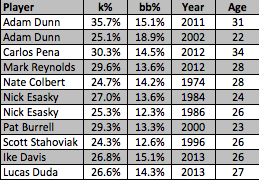Clik here to view.

Trade rumors are swirling around Ike Davis and Lucas Duda. The Mets seem ready and willing to move one of their two left-handed first basemen. Which player should the Mets trade?
Jeff Wilpon was recently quoted as saying the Mets have a "glut" of first basemen. That quote requires about a dozen caveats but at its core is a factual statement. The Mets have both Lucas Duda and Ike Davis and their mutual presence on the Mets' roster is redundant.
It's no secret that the Mets are shopping the two lumbering first basemen. Jon Heyman reported that as many as five teams had expressed interest in Davis. It's not so much a question of if Duda or Davis will be traded but when. The question then becomes, "Which player should the Mets trade?"
Earlier this year, a poll of nine anonymous scouts chose Duda over Davis. Duda posted a wRC+ of 120 in 2013 while Davis's wRC+ was just 90. When looking at just this past season—and considering the fact that Duda has an extra year of team control—it's clear Duda is the more valuable player.
However, when you look a bit further into the past, the picture becomes more muddled. Davis bounced back from a slow start in 2012 to hit 32 home runs. In an increasingly power-starved league, the fact that Davis has that potential makes him desirable. Contrast that with Duda, who has yet to have an ISO greater than .200 since his brief debut in 2010 and is also a year older than Davis. The Steamer projection system likes Davis slightly better than Duda, projecting a triple slash of 238/.341/.439 versus .237/.335/.405 for Duda.
A couple of months ago, Steve Staude posted an excellent article on Fangraphs about strikeout rates and why they correlate with power. The basic idea is that strikeouts and power are correlated, but not for the reasons you might think. A player who strikes out a lot doesn't get on base as much as a player who strikes out less frequently, so they need to add value in other areas. They remain in the majors despite their high strikeout rates because they have another tool, and that tool is usually the ability to hit home runs. This is especially necessary if you are at the bottom of the positional spectrum.
Clik here to view.

(Photo credit: Brad Mills-USA TODAY Sports)
How does this relate to Ike Davis and Lucas Duda? Well, obviously, they strike out a whole bunch. In 2013, among batters with a minimum of 350 plate appearances, Davis and Duda finished right next to each other with the 23rd and and 24th highest strikeout rates in baseball (26.8% and 26.6% respectively).
The problem here is that the latest vintage of these players did not hit for the requisite power to make up for their high strikeout rates. I wanted to find players with similar profiles who had posted similar seasons to see what the future may have in store Davis and Duda. So I turned to the Baseball-Reference Play Index and searched for players aged 25-29 who played 25% of their games at first base (which is important because it indicates limited defensive value), had 350 plate appearances, struck out greater than 24% of the time, and posted an ISO under .210. Here are the results:
Image may be NSFW.
Clik here to view.
(click to embiggen)
As you can see, the results are not pretty. The best-case scenario is Andres Galarraga, who had an early-30s revival in the thin air of Colorado. That there are so few similar seasons is a testament to the abovementioned assertion that you need to hit for power if you're going to strikeout in a quarter or more of your plate appearances.
At this point you might be looking at Davis's and Duda's walk rates and saying, "Hey, there's a carrying tool!" Certainly, the sky-high walk rates they posted helped buoy their overall value. Going back to the Baseball-Reference Play Index, I did the same search as above but also looked for walk rates above 12% while eliminating the age requirement.
Image may be NSFW.
Clik here to view.
(click to embiggen)
What we see is a mix of players who are either on their way out of the game or on their way up. Adam Dunn appears twice as he smooths out the bell curve of his career. Mark Reynolds and Carlos Pena are presumably on their way out. A high walk rate just isn't enough to make up for the lack of contact, power, and positional value.
There are certainly problems with this simplistic analysis, not the least of which is that the numbers aren't park-adjusted. It should also be noted that both players have hit right-handed pitching very well in their careers. But I still think this gets us to the larger point that both players need to consistently hit for more power overall if they want to be major league regulars going forward.
So which player should the Mets trade? Does it really matter? I agree with Marc Carig that they should let the market decide. They should trade whoever can bring back the greatest return. Or trade both and look for a solution externally, because at this point it seems unlikely that either player will be providing much value in the years ahead.
